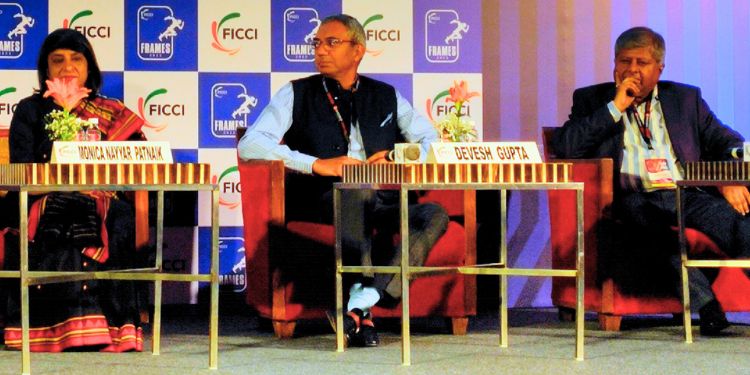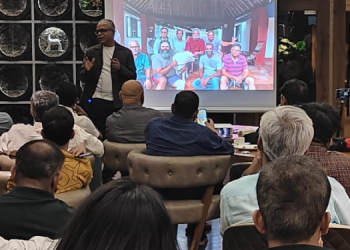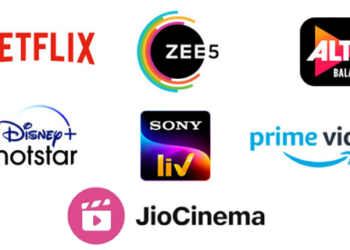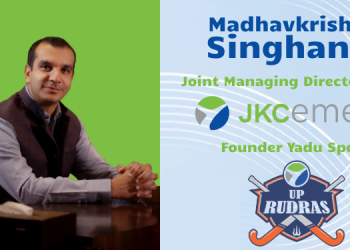A session titled ‘Print 2030’ at FICCI Frames 2023 delved into the future of print media. The need for measurement and the credibility of newspapers was in focus.
Speakers were Monica Nayyar Patnaik, Managing Director, Sambad Group; Devesh Gupta, Executive President, Jagran; and Shashi Sinha, CEO, Media Research Users Council India (MRUCI) and CEO, IPG Mediabrands India.

Reflecting on the future of print, Sinha said, “I believe in the power of print. There is a huge credibility that the print medium brings when compared to digital and television.”
He pointed to the built-up infrastructure that newspapers have to provide fast, cheap and credible news.
“Print in this country has been too dependent on ad revenues. You will find circulation and subscription revenues are very important and the big players are to be blamed; the English print players based in Mumbai, Delhi, and Bengaluru are responsible for undervaluing the product and not taking the pricing up. Now, there is a conundrum: if I take the prices up, the numbers will drop. Let the numbers drop. Regional (papers) wise, the cover prices are good. A state should arrive that around 40 pc of the print media revenue should come from subscription and automatically the advertisers will start paying higher.”

Gupta added on the topic of pricing disparity: “I would cite the example of Uttar Pradesh. UP constitutes 60 pc of sales more or less for Dainik Jagran. If I were to compare the prices with the pre-pandemic period, I have taken a 51 pc price rise in UP in cover price. India is a very price-sensitive market. Even if I increase Rs.2, the sales fall. I have taken a Rs.4 to 5 price rise since the pandemic in the last two to three years. Every time I have lost sales. As of now, there is no scientific way to say how much percentage was lost because of that. We safely assume, most of the industry reports point to a 5 to 10 percent permanent loss in sales due to the change in reading habits. Rest is because of the price.”
He explained that in UP, with a rise in pricing by 51 pc, Jagran lost about 20 to 25 pc copies.
“If you worked out the actual finances, the dumping value of a paper is enough for an agent to buy copies from us and not actually sell it and dump it and still attain breakeven. We got rid of it because of higher pricing. In some states like Bihar, we barely took a cover price increase of 10 pc; currently we are doing 92 to 95 pc of our pre-Covid circulation,” explained Gupta.
On the competition from other news mediums, he said, “I strongly believe that with the digital media and smartphone penetration in this country, print cannot be in the breaking news race, that podium we have to leave to digital and TV. Print has been rated highest in terms of credibility as per different surveys conducted. We need to capitalise on the credibility part of print. We need to add value to whatever we are printing and in-depth coverage. Community building happens along with that.”
Measurement is Queen
Measurement of print readership – or the lack and delay of it – has been a bone of contention several times in the past.

Patnaik said, “We are definitely very interested to get the geographic area to be represented but when we go to MRUCI, there is a lot of money involved. The research done is at a very miniscule level / number. We are not able to get the final output for the readership. We need to expand, which requires investments.”
Gupta said, “From a publisher perspective, it is an open fact that almost every publisher lost a lot of copies in the pandemic. One reason why this delay (in measurement) is happening was publishers are not so keen on the exact measurement coming out in the market. They might still want to live with the earlier numbers which are no longer there. The numbers that would come out would be far lower than what most of the publishers are claiming today. Unfortunately, the publishers are sceptical about the ad revenue. Definitely, the industry requires measurement metrics.”
Sinha commented, “I am part of two industry bodies, (for measuring) print and television. TV revenues are manifold compared to the print media. TV measurement costs about Rs.300 crore, print comes to Rs.25 crore. When the measurement started print and TV were the same size. Television players put 1 pc of their ad revenue and it has grown. I generally believe measurement contributes in the long run to the growth of the industry. In the case of print, lack of measurement has somewhere hurt the industry in the long run. The fact is that, I believe that in the long run, measurement will help the industry grow.”
The rise post Covid
Opening the discussion with the Covid experience was Patnaik, representing the Oriya daily that is part of the Sambad group, which also houses an Odiya TV channel, among others.
She said, “We had difficulties. It was not so easy during the pandemic period. There were three aspects. For print it was circulation, ad revenue, and the third most important factor for us was manpower. We started in 1984 and the manpower has been an integral part of the system and being in the sector, we couldn’t do anything for them initially. We were stuck as to how we will steer forward.”
Once circulation was hit, 50 pc of the ad revenue was also hit. But the salaries, consumables, and the news print cost still remained, explained the speaker.
“The question was what will we do for our people. We retained all of them. We did the initial salary cut which was revived later. It was a deferment and later revived. The manpower played a key important role for the group,” she added.
It was a good time, as Sambad Group discovered, to engage in community building across stakeholders.
Patnaik, added, “We connected with the communities and started building from the base with small discussions. We developed relationships amongst our employees, the hawker agent and distribution centres, as well as subscribers and readers for a direct connect. We are still to revive, we have still not revived 100 pc, it is the same case with other print players as well.”
On expectations and hopes for regional and English print media, Patnaik said, “We have been hearing that print media is going to be dead from years back, but it is still surviving. There is a lot of scope for improvement whether it is for English or regional dailies. India is still with the print media. We are not going anywhere. Print media is the most reliable, trustworthy, value-oriented medium as of now.”
Sharing Jagran’s experience during the pandemic, Gupta said, “In Covid times the first challenge was to get distribution in place because without the sale of newspapers, there will be no subscription or ad revenue. Thankfully being in media, we were the first ones to get permission to have our vehicles move around during the period.”
He explained how they used the opportunity to do something innovative.
“In the early days a lot of FMCG and other companies were struggling with distribution because they were not allowed to move like a press vehicle. We were approached by Dabur, we tied up with them and used our network and manpower to help them move their goods. It was a win-win for both parties. Since the (newspaper) sales were much lower, the margins our trade distribution network partners were making were also reduced to a significant extent. To help them earn a little more, we asked them to sell certain things like masks, sanitisers, related to the pandemic. We used that and did a trial project for a month in most of the cities in UP. We did a turnover of more than Rs.20 lakh and more importantly it provided extra income to the network partners,” added Gupta.
“We slowly and steadily got our distribution network in place and obviously ad rates were reduced. We also didn’t do major manpower reduction. We could sustain losses for a few months. Pandemic was a learning period for us because we were able to relook at our cost from a zero angle. We were able to cut down on several unnecessary expenses. During the period, we combined some of our editions. We did all these things to reduce the costs,” the speaker elaborated.
Gupta added that print as a medium was still reviving.
















